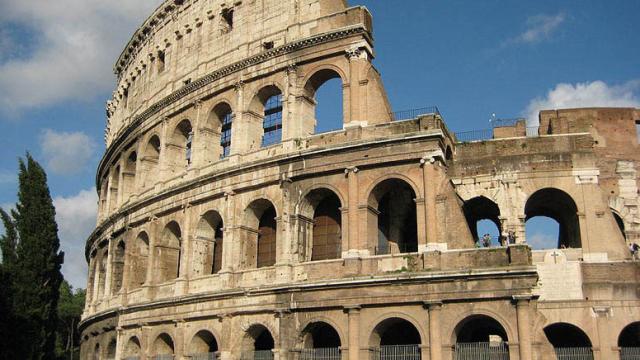The Colosseum in Rome is being cleansed of car exhaust that has built up over decades, ever since Mussolini’s ill-advised decision to build a major road nearby.
The exhaust, however, is just part of an overall mixture known as “black rust,” CBS News reports: “Exhaust, pollen, algae and fungus growths form a coating the restorers call ‘black rust’ which has to be washed with non-chemical solutions and rubbed off gently in order not to damage the stonework.”
I’m writing this, unfortunately, without access to my copy of David Gissen’s excellent book Subnature, but it is full of interesting examples of how the pollution accumulating on historical monuments around the world offers its own weird form of cultural and industrial history. The idea that buildings, statues, and other structures — even geological features — should be scraped clean of their everyday chemical environments is, of course, obvious from the point of view of wanting to preserve their vulnerable rocks and masonry. But it is also, Gissen suggests, somewhat over-enthusiastic or even misguided to think that we can return something to its “original” state. In fact, he argues that to see these structures in their natural — or, as he puts it, subnatural — context we should see them still dotted with weeds, pollution, dust, even bird crap and gum.
After all, the candle-blackened interiors of churches, or the dusty banisters of private homes, are as revealing of the lifestyles of the people who once lived in or used those buildings as are the carefully polished surfaces we might encounter on the old knick-knacks in a museum. Even centuries of wood smoke and other layers of urban pollution that accumulated on, say, Notre Dame in Paris before it was cleaned in the 1990s are not without their historical insights. Spotlessly white stone exteriors are not necessarily historically accurate, in other words, at least not in the sense that any city — except perhaps Singapore — can boast of a truly sterile condition for its major public and private structures.
Gissen points out that perhaps there is an unexpected interpretive value in the grime now coating parts of the urban world, and, even if that grim shouldn’t be saved, there is value in taking a closer look at it before rushing to wash it away.
This is not to suggest that we shouldn’t clean the Colosseum, as this toxic mixture of contaminants would eventually eat the building away, like a tooth disappearing in a glass of Pepsi. But it is to say that it might be worth saving a small section of the building — even just a disconnected stone that poses no risk of structural decay — to remind future visitors of what the urban context can really do to even its most monumental inhabitants.
Think of the small patch of smoke-stained ceiling in New York’s Grand Central Station. Unbeknownst to most commuters, there is a tiny spot on the ceiling where restorers left a small, secret historical reminder:
Look up at the ceiling: In the northwest corner, you’ll see a little square black patch. Now imagine extending that colour across the entire constellation that’s painted on the ceiling. That’s what was there before Grand Central Terminal was dramatically restored in the 1990s. That little black patch was left as a reminder of the bad old days. And what exactly does that black patch consist of? Decades of dirt? Try again. It was the result of decades of smoking in the terminal. That’s old nicotine and tobacco residue that was preserved, and it’s a testament to how dramatic this restoration was.
Perhaps something similar could be left on the Colosseum, to remind us of the blackening presence of roads and the bad decisions of earlier urban planners. [CBS News]
Lead image via Wikimedia Commons
